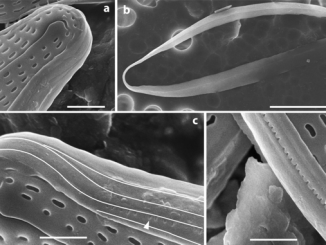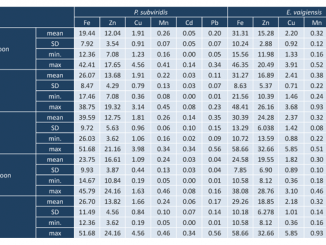
Paper category: Original research paper
Corresponding author: Jolanta Ejsmont-Karabin (jolanta@onet.pl)
DOI: 10.1515/ohs-2020-0011
Received: 19/08/2019
Accepted: 04/11/2019
Full text: here
Citation (APA style): Oceanological and Hydrobiological Studies, Volume 49, Issue 2, Pages 123–131, eISSN 1897-3191, ISSN 1730-413X, DOI: https://doi.org/10.1515/ohs-2020-0011.
Abstract
We have determined how Crustacea, zebra mussels (Dreissena polymorpha), fish and nutrients affect the trophic state in mesocosms filled with water collected from the pelagic zone of a eutrophic lake. We hypothesized that the pool of nutrients would increase both directly due to the input of phosphorus and nitrogen and/or indirectly due to the introduction of animal biomass. We used trophic state indices based on the abundance and species structure of rotifers to assess changes in the trophic state in mesocosms. The role of small detritophages in rotifer communities increased as a result of treatments. Our results clearly demonstrated that D. polymorpha was able to reduce the trophic status of mesocosm waters as indicated by reduced rotifer trophic state indices regardless of interactions with other treatment factors. Contrary to our expectations, neither the nutrients added at the beginning of the experiment nor the introduction of crustaceans or fish affected the rotifer trophic indices.
References
Beaver, J.R. & Crisman, T.L. (1990). Use of microzooplankton as an early indicator of advancing cultural eutrophication. Verh. Internat. Verein. Limnol. 24: 532–537.
Bloesch, J., Bossard, P., Bührer, P., Bürgi, H.R. & Uehlinger, U. (1988). Can results from limnocorral experiments be transferred to in situ conditions? Hydrobiologia 159: 297–308. DOI: 10.1007/BF00008242.
Bossard, P. & Uehlinger, U. (1993). The effect of herbivorous crustacean zooplankton on epilimnetic carbon and phosphorus cycling. Hydrobiologia 254: 21–34. DOI: 10.1007/Bf00007762
Drenner, R.W., Smith, J.D. & Threlkeld, S.T. (1996). Lake trophic state and the limnological effects of omnivorous fish. Hydrobiologia 319: 213–223. DOI: 10.1007/ BF00013734.
Dzialowski, A.R. & Jessie, W. (2009). Zebra mussels negate or mask the increasing effects of nutrient enrichment on algal biomass: a preliminary mesocosm study. J. Plankton Res. 31: 1437–1440. DOI: 10.1093/plankt/fbp071.
Ejsmont-Karabin, J. (1998). Empirical equations for biomass calculation of planktonic rotifers. Pol. Arch. Hydrobiol. 45: 513–522.
Ejsmont-Karabin, J. (1983). Ecological characteristics of lakes in north-eastern Poland versus their trophic gradient. VIII. Role of nutrient regeneration by planktonic rotifers and crustaceans in 42 lakes. Ekol. pol. 31: 411–427.
Ejsmont-Karabin, J. (2012). The usefulness of zooplankton as lake ecosystem indicators: rotifer trophic state index. Pol. J. Ecol. 60: 339–350.
Ejsmont-Karabin, J., Gorelysheva, Z., Kalinowska, K. & Węgleńska, T. (2004). Role of zooplankton (Ciliata, Rotifera and Crustacea) in phosphorus removal from cycling: lakes of the River Jorka Watershed (Masuria Lakeland, Poland). Pol. J. Ecol. 52: 275–284.
Fahnenstiel, G.L., Gregory, A., Lang, G.A., Nalepa, T.F. & Johengen, T.H. (1995). Effects of Zebra Mussel (Dreissena polymorpha) Colonization on Water Quality Parameters in Saginaw Bay, Lake Huron. J. Great Lakes Res. 21: 435–448. DOI: 10.1016/ S0380-1330(95)71057-7.
Gannon, J.E., Stemberger, R.S. (1978). Zooplankton (especially crustaceans and rotifers) as indicators of water quality. Trans. Amer. Micros. Soc. 97: 16–35. DOI: 10.2307/3225681 https://www.jstor.org/stable/3225681.
Gilbert, J.J. (1988). Suppression of rotifer populations by Daphnia: A review of the evidence, the mechanisms, and the effects on zooplankton community structure. Limnol. Oceanogr. 33: 1286–1303. DOI: 10.4319/lo.1988.33.6.1286.
Goedkoop, W., Naddafi, R. & Grandin, U. (2011). Retention of N and P by zebra mussels (Dreissena polymorpha Pallas) and its quantitative role in the nutrient budget of eutrophic Lake Ekoln, Sweden. Biol. Invasions 13: 1077–1086. DOI: 10.1007/s10530-011-9950-9.
Gutsch, M. & Hoffman, J. (2016). A review of Ruffe (Gymnocephalus cernua) life history in its native versus non-native range. Rev. Fish Biol. Fisheries 26: 213–233. DOI: 10.1007/s11160-016-9422-5.
Hessen, D.O. & Nilssen, J.P. (1985). Factors controlling rotifer abundances in a Norwegian eutrophic lake: an experimental study. Annls Limnol. 21: 97–105. DOI: 10.1051/limn/1985017.
Jeppesen, E., Jensen, J.P., Sondergaard, M., Lauridsen, T. & Landkildehus, F. (2000). Trophic structure, species richness and biodiversity in Danish lakes: changes along a phosphorus gradient. Freshw. Biol. 45: 201–218. DOI: 10.1046/j.1365-2427.2000.00675.x.
Kamarainen, A.M., Penczykowski, R.M, Van de Bogert, P.C.H. & Carpenter, S.R. (2009). Phosphorus sources and demand during summer in a eutrophic lake. Aquat. Sci. 71: 214–227. DOI: 10.1007/s00027-009-9165-7.
Karatayev, A.Y., Burlakova, L.E. & Padilla, D.K. (2005). Contrasting Distribution and Impacts of Two Freshwater Exotic Suspension Feeders, Dreissena polymorpha and Corbicula fluminea. In R.F. Dame & S. Olenin (Eds.), The Comparative Roles of Suspension-Feeders in Ecosystems (pp. 239–262). NATO Science Series IV: Earth and Environmental Series, vol 47. Springer, Dordrecht, The Netherlands, 2005, ISBN 978-1-4020-3028-4.
Paterson, M.J., Findlay, D.L., Salki, A.G., Hendzel, L.L. & Hesslein, R.H. (2002). The effects of Daphnia on nutrient stoichiometry and filamentous cyanobacteria: a mesocosm experiment in a eutrophic lake. Freshw. Biol. 47 1217–1233. DOI: 10.1046 /j.1365-2427.2002.00842.x.
Pejler, B. (1983). Zooplanktonic indicators of trophy and their food. Hydrobiologia 101: 111–114. DOI: 10.1007/BF00008662.
Petrosyan, V.G. (2014). The integrated database management system and the statistical analysis of biological data / Biosystem office. Russian Federal Service for Intellectual Property. Certificate 2014663194, Date of registration 18.12.2014. http://www1.fips.ru/fips_servl/fips_servlet?DB=EVM&DocNumber=2014663194&TypeFile=html
Pociecha, A., Bielańska-Grajner, I., Kuciel, H. & Wojtal, A.Z. (2018). Is zooplankton an indicator of the water trophic level in dam reservoirs? Oceanol. Hydrobiol. St. 47(3): 288–295.
R Core Team (2017). R: A language and environment for statistical computing. R Foundation for Statistical Computing, Vienna, Austria. URL http://www.R-project.org/.
Reinertsen, H. & Langeland, A. (1982). The effect of a lake fertilization on the stability and material utilization of a limnetic ecosystem. Holarctic Ecol. 5: 311–324. DOI: 10.1111/j.1600-0587.1982.tb01045.x.
Sarnelle, O., White, J.D., Horst, G.P. & Hamilton, S.K. (2012). Phosphorus addition reverses the positive effect of zebra mussels (Dreissena polymorpha) on the toxic cyanobacterium, Microcystis aeruginosa. Water Res. 46: 3471–3478. DOI: 10.1016/ j.watres.2012.03.050.
Stenson, J.A.E. (1982). Fish impact on rotifer community structure. Hydrobiologia 87: 57–64. DOI: 10.1007/BF00016662.




Be the first to comment